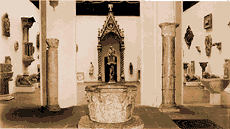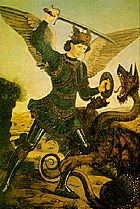
Interior of the museum
Leaving Porta San Niccolò to your rear, you come to Piazza dei Mozzi
after only a short walk from Piazza Poggi along Lungarno Serristori or Via
San Niccolò in the direction of the city centre; here you can
find the Bardini Museum, one of the less important Florentine museums which,
however, possesses a fascination that is all its own. It was originally
the house and warehouse of antiquarian and art collector Stefano Bardini
(1836-1922) who left it and all its contents to the City Council.

St.Michael
by A.Pollaiolo
Built in the 19th century, the palace itself is unusual because all
the doors, windows, architraves and wooden ceilings used for its construction
came from destroyed churches or villas. The Museum, which was opened
in 1925, contains a great many extremely interesting works of art, among
them the marble Charity by Tino da Camaino (1329
c.), the Archangel St. Michael by Antonio del Pollaiolo and a recently restored Crucifixion,
dating from the 13th century: painted several decades before Cimabue, this is one of the oldest Florentine paintings
in existence.

Wooden Our
Lady
(XIV century)
As a whole, the collection, beautifully arranged on two floors, is a unique example of the antiquarian taste of the late 19th century and includes a great many sculptures (from classical times to the 17th century), paintings, furniture, ceramics, tapestries, arms, carpets and some rare musical instruments.
